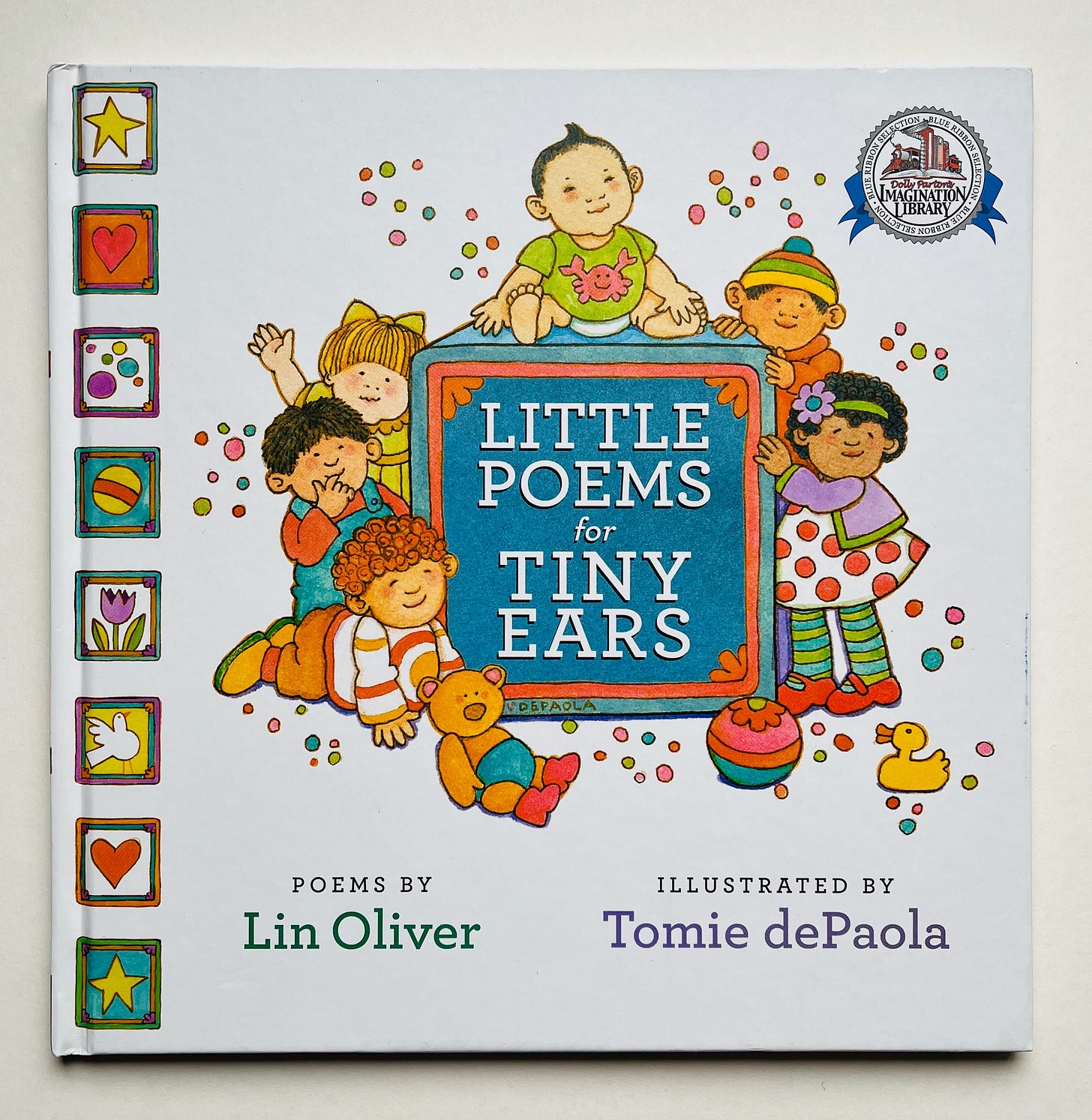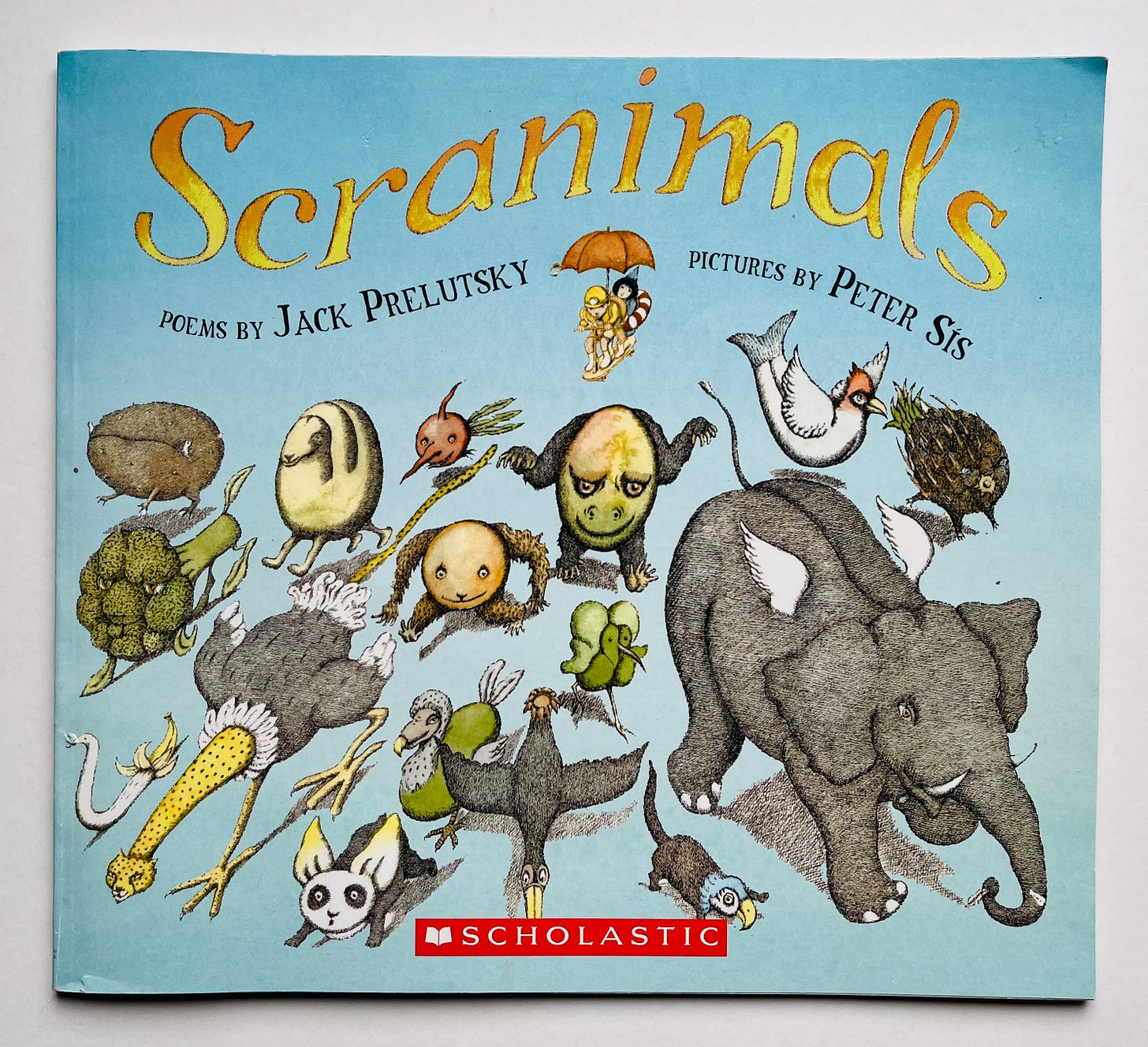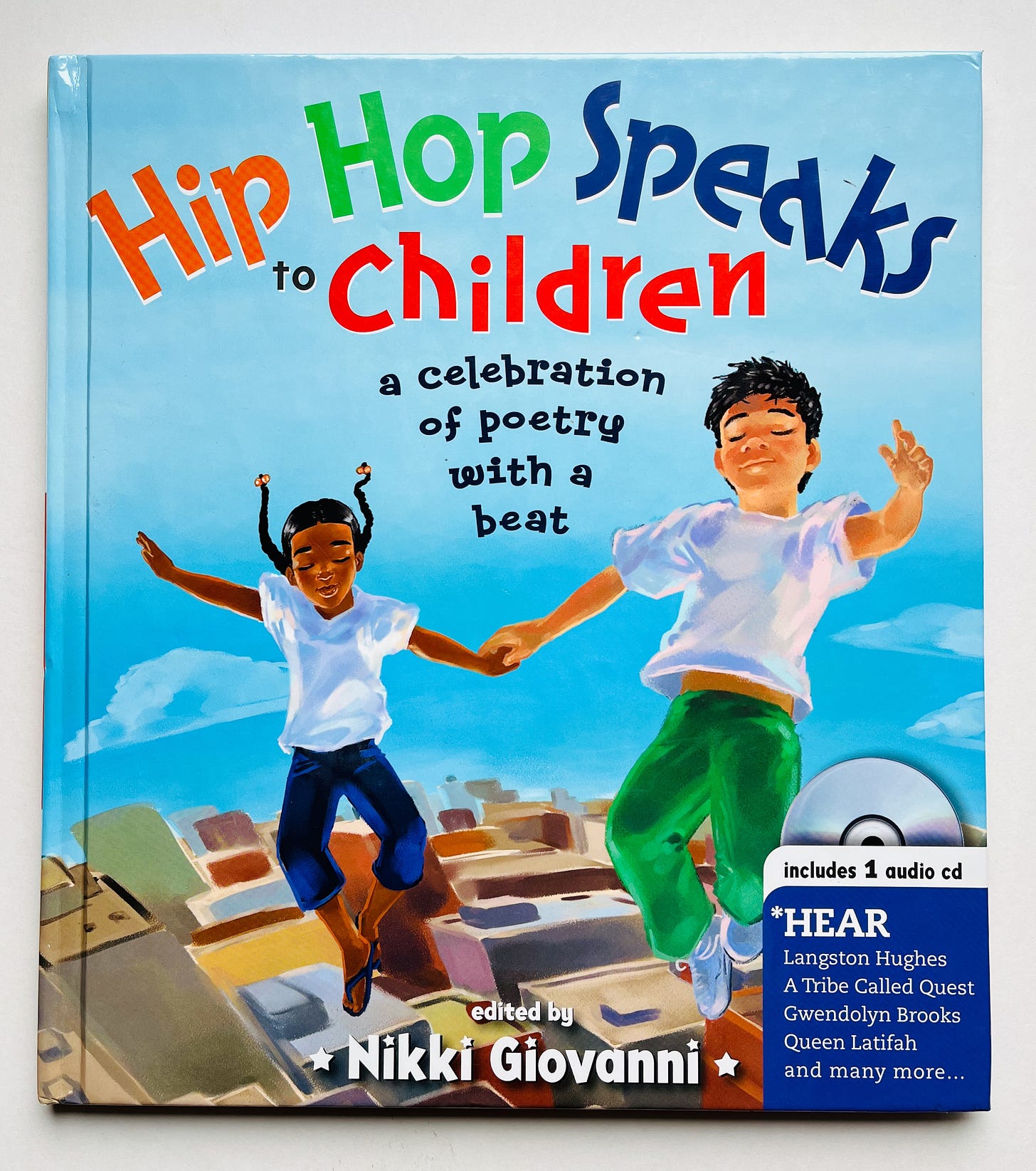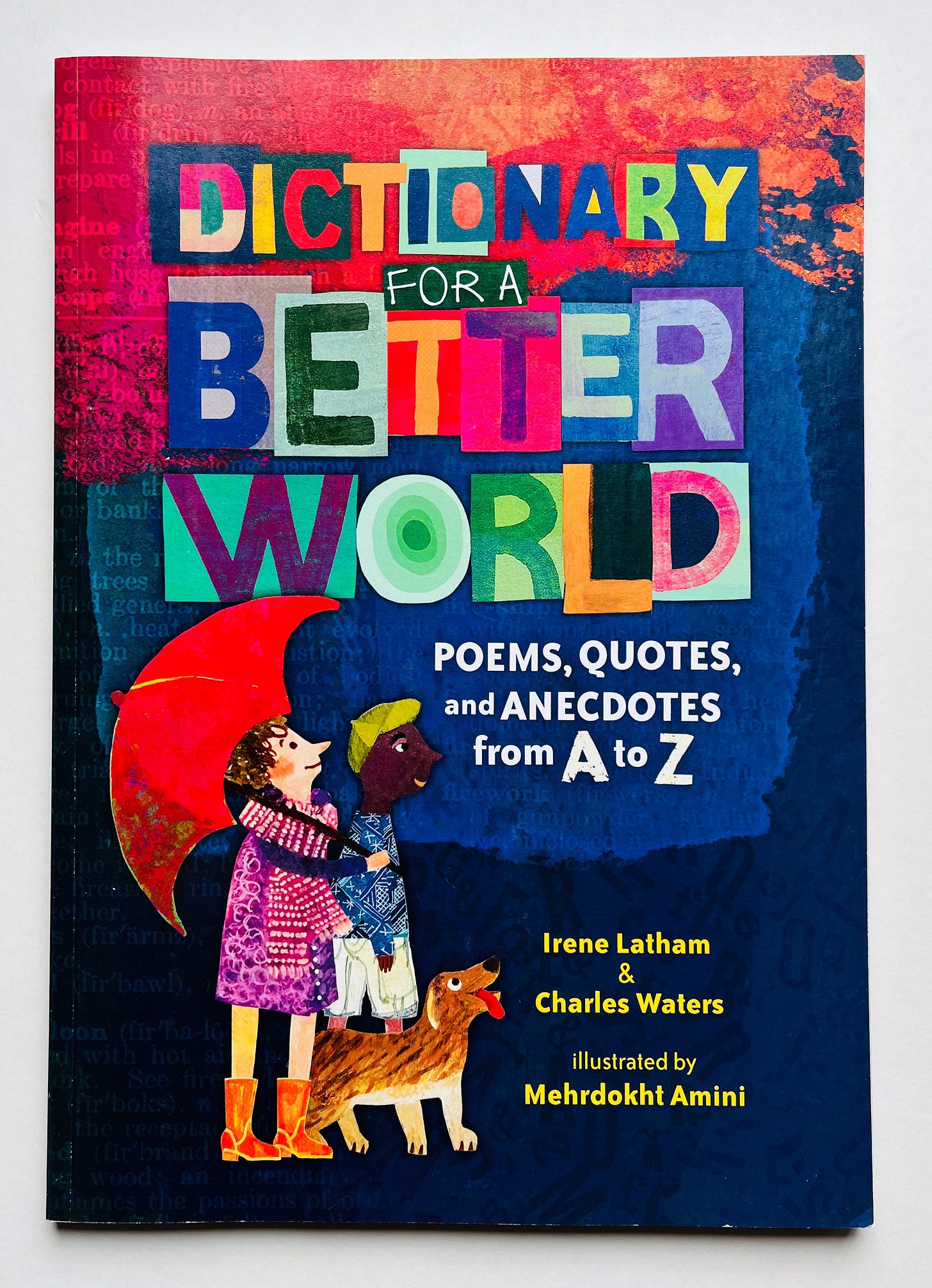Don’t think poetry is important, or worth reading? Do you struggle to “get it?” Do you remember analyzing poems in school til you were so bored any joy was sucked out of the words and you, so you avoid reading poetry to your own children?
It’s okay. You’re in the right place.
I am here to tell you that poetry is extremely important.
I am here to tell you that you don’t have to “get it” now — or ever — to enjoy it.
I am here to tell you that no matter your past experience with poetry, you can heal your poetry trauma and find poems that you truly love reading with your family.
I’ve written before about why poetry matters for kids. There are a lot compelling reasons, which I break down piece by piece. If you haven’t read that, take a minute and follow that link — I’ll wait.
(If you’re back but need further persuading, read this interview I did with children’s poetry experts Sylvia Vardell and Janet Wong in May 2022 — if they don’t convince you, I’m not sure who will.)
If you’re fully on board with poetry but don’t know where to begin, well, that’s what I’m offering you today — an entry point🚪
Though this Spotlight On issue is by no means exhaustive — I love and recommend so many poetry books for kids — I aimed to compile a short and accessible list, with a variety of titles for all ages that are readily available at the library and in bookstores.
Because adding poetry into your routine is part of building a culture of reading in your home, and I know that’s what you’re here for.
Because poetry speaks to us on a deep, utterly human level.
Because, as Nikki Giovanni wrote in the introduction to Hip Hop Speaks to Children (reviewed below):
“When humans were beginning to develop our own language, separate from the growls and howls, separate from the buzz and birdsongs, we used rhythm: a sound and a silence. With no silence, the sound is cacophonous. With no sound, the rhythm is a lonely owl flapping her wings against the midnight sun seeking a careless mouse.”
We need silence and rhythm in equal measure — in books and in life — and that’s poetry.
Read on.
Little Poems for Tiny Ears by Lin Oliver, illustrated by Tomie dePaola (2014)
Think babies can’t enjoy poetry? Think again.
Coupled with dePaola’s signature style of illustration — transparent acrylics on handmade watercolor paper — Oliver has written entertaining verses full of all the things that make up a baby’s world: seeing oneself in the mirror, the joys of making noise, strollers and car seats, dogs and cats, playing peekaboo, belly buttons, and, of course, the ever-enticing kitchen drawer.
This is a perfect title to pick up and read from when you have a captive audience — during mealtimes, when small listeners are in high chairs, or in the bathtub, if they can safely sit up by themselves. They likely won’t have the patience to sit through the whole thing and that’s fine — this one is for dipping your toes into… before putting your toes into your mouth.
¡Pío Peep! Rimas tradicionales en español / Traditional Spanish Nursery Rhymes selected by Alma Flor Ada and F. Isabel Campoy, English adaptations by Alice Schertle, illustrated by Viví Escrivá (2003)
This sweet, fun collection of Spanish nursery rhymes and songs offers a rich feast of Latino oral history for the smallest among us, from ancient medieval ballads and old harvest songs to finger plays and lullabies.
Don’t let that intimidate you, though — Flor Ada, Campoy, and their translator, Schertle, are very, very good at what they do, and they have chosen some absolute gems that, if it were up to me, would be read to every baby and toddler in the land.
See how the words sing in both English and Spanish?
Un elefante se balanceaba
sobre la tela de una araña
Como veía resistía
fue a llamar a otro elefante.//
One brave elephant
swung on a silver thread.
’A web in a breeze is a lovely trapeze,
more elephants, please,’ he said.
(The first stanza of “Los elefantes”)
The richness of each language is presented simply but absolutely beautifully here. Accompanied by a cd featuring each poem as a song set to music, and Escrivá’s watercolor and ink illustrations — which are so adorable it’s almost painful — this book is basically perfect.
If you have tiny ones, don’t miss it.
National Geographic Book of Animal Poetry: 200 Poems with Photographs that Squeak, Soar, and Roar!, edited by J. Patrick Lewis (2012)

This utterly gorgeous, crowd-pleasing title was a winner from the moment I first introduced it at our poetry teatime years ago. The poets themselves are well-known — their body of work certainly leans toward the last 50-60 years, and the language is all completely accessible to contemporary children and adults — so much of what normally scares people away from poetry doesn’t exist here.
This book is exactly as advertised — animal poetry accompanied by National Geographic photographs — and that really tells you all you need to know about the quality within. I highly recommend this if you don’t know where to start with children’s poetry. What kid doesn’t like poring over pictures of animals? Then you just sneak in some beautiful words on the side.
Scranimals by Jack Prelutsky, illustrated by Peter Sís (2002)
If you have a child who enjoys wordplay, or having fun with language, or mixing things up to make something new, look no further than Scranimals, Prelutsky’s amusing and utterly unique poems that, well, scramble up animals and food to create weird, new creatures.
Like what, you ask?
Like “A Clutch of Spinachickens,” who are “mostly leafy green,” though “their heads are smooth as leather,” and their brains “not too keen.”
Or the “Sweet Porcupineapple,” an “unflappable chap” who will “happily amble all over the map.” (“Not many should chew you, not many have tried.”)
Or, that lengthy, elusive fellow, “Oh Sleek Bananaconda” — “how sinous and sly you are, how slippery, how yellow.”
Sís’ wonderfully bizarre black line art combined with watercolors provide illustrations that are as interesting to look at as Prelutsky’s masterful verse is to listen to, creating a perfect package of the purely peculiar. These are delightful to read aloud to anyone ages 4-10, and to discuss… what scranimal would you create?
Hip Hop Speaks to Children: A Celebration of Poetry with a Beat edited by Nikki Giovanni, illustrated by Kristen Balouch, Michele Noiset, Jeremy Tugeau, Alicia Vergel de Dios, and Damian Ward (2008)
“Poetry with a beat. That’s hip hop in a flash. One part story, one part rhythm.” So says master poet Nikki Giovanni in her introduction to this upbeat (pun intended, of course) and comprehensive collection of poetry from a wide variety of Black voices.
Poems from iconic people like W.E.B. DuBois, Martin Luther King, Jr., Langston Hughes, and Paul Laurence Dunbar are offered side by side with more recent authors like Gwendolyn Brooks, Lucille Clifton, Maya Angelou, and Eloise Greenfield — along with perhaps more famous names that kids might recognize, like Kanye West, Lauryn Hill, and Tupac Shakur. What sets this collection apart is its superior quality — it is, to a poem, excellent — as well as its ability to please a broad range of ages and tastes.
It is also simply beautiful.
your breath
is your promiseland
if you want to feel very rich
look at your hands
that is where
the definition of magic
is located at
(from “Love Poem for My People” by Nuyorican poet and playwright Pedro Pietri)
The accompanying cd, featuring many poets reading their own work, and the six illustrators who lent their varied talent to the images in a mishmash of media and styles, works well in bringing each piece vividly to life (and is highly recommended, if you can get your hands on a copy of the book that includes one). This is a long-lasting, stunning addition to any home, classroom, or library — one to keep, and go deep into, over many years.
Revolting Rhymes by Roald Dahl, illustrated by Quentin Blake (1982)
Leave it to wicked, hilarious Roald Dahl to take a handful of classic fairy tales — Cinderella, Jack and the Beanstalk, Snow-White and the Seven Dwarfs, Goldilocks and the Three Bears, Little Red Riding Hood and the Wolf, and The Three Little Pigs — and turn them into wicked, hilarious poems.
If your children are familiar with the original stories — and ready for narrative revisions and some language that’s a bit more vulgar than what you’d find in tamer retellings — then this is the book for you.
Take this bit from “Goldilocks and the Three Bears,” after the bears have headed out for a walk because their breakfast is too hot:
No sooner are you down the road
Than Goldilocks, that little toad
That nosey, theiving little louse,
Comes sneaking in your empty house.
She looks around. She quickly notes
Three bowls brimful of porridge oats.
And while standing on her feet,
She grabs a spoon and starts to eat.
I say again, how would you feel
If you had made this lovely meal
And some delinquent little tot
Broke in and gobbled up the lot?
As ever, Blake’s pen, charcoal, and watercolor illustrations are uproarious, and they appear here more frequently than in the author’s and illustrator’s lengthier collaborations in Dahl’s novels, but the frequent images will not make this easier for younger kids — these twisted versions are best for middle-grade readers. But when you’re at a point where you can appreciate deviations from what you know and even a bit of comedic violence in the name of exaggeration, these are awfully fun to read aloud and cackle over together.
Dictionary for a Better World: Poems, Quotes, and Anecdotes from A to Z by Irene Latham and Charles Waters, illustrated by Mehrdokht Amini (2020)
There are many wonderful poetry titles out there for older kids, but if you are looking for something distinctive and, it should be said, of the moment, I don’t think you’ll find a better option than this “dictionary.”
Here, Latham and Waters — separately and together — have written a collection of poems that feature “words to create a better world,” with titles for each letter of the alphabet, like “Ally,” “Empathy,” “Hope,” “Listen,” “Open,” “Pause,” “Service,” “Upstander,” and “Yes.” As if that isn’t creative enough, each poem showcases a different poetic form — “Gratitude” is an ode; “Humanity,” a triolet; “Justice,” a chant; “Question,” a villanelle — and includes a quote from a person or a literary source, and a short note from the authors, offering their own take on the topic.
Amini’s digital illustrations complement each poem in tone, putting the focus on the words and the feelings they evoke rather than artistic prowess, which is exactly the right strategy for a book that asks so much of the reader.
In an author’s note at the end, Latham and Waters write:
While we both want to help make the world a better place, we are hyperaware of our limitations,. Sometimes the best — and only — thing we can do is to improve ourselves and allow those changes to slowly ripple out into the world. Other times, when we join with others, change can feel like it’s happening quickly. We believe it is our job as humans to first be courteous and to at least try. We’re not experts, and we sure don’t know everything. We remain works in progress, even as adults. We’re learning every day.
This is one of the poetry books I turn to for solace and hope when I cannot take any more of the world’s darkness (so, my copy is well-thumbed) and it’s this posture of humility — embodied in every superb poem — that gives me the strength to keep improving myself regardless of how bleak things get, to continue to “at least try,” to remember I’m a work in progress.
Hand this to your high schooler, or another adult friend, or buy it for yourself. It’s a matchless reminder of that Brené Brown quote, “You’re imperfect, and you’re wired for struggle, but you’re worthy of love and belonging.”
Among many other things, poetry helps us see — and believe — that.
My list of recommended poetry books is about five times as long as this, but I’m limiting myself in order to keep it manageable. If you’re looking for poetry for a certain age, on a specific topic, or in a particular style, hit reply and I’ll send some suggestions your way.
If I’ve reviewed any of the following titles, I’ve linked to the issue in parentheses.
Also highly recommended
I Remember: Poems and Pictures of Heritage by Lee Bennett Hopkins
The Neighborhood Mother Goose by Nina Crews (issue No. 49 — for babies and toddlers)
The Nursery Collection by Shirley Hughes (issue No. 25 — for babies and toddlers)
The Proper Way to Meet a Hedgehog and Other How-To Poems by Paul B. Janeczko
Once Around the Sun by Bobbi Katz (issue No. 48)
The Barefoot Book of Earth Poems by Judith Nichols
The Random House Book of Poetry for Children by Jack Prelutsky
Fresh-Picked Poetry: A Day at the Farmers’ Market by Michelle Schaub
Dark Emperor and Other Poems of the Night by Joyce Sidman (issue No. 43)
A Stick Is an Excellent Thing: Poems Celebrating Outdoor Play by Marilyn Singer (Children’s books about outdoor play)
Feel the Beat: Dance Poems that Zing from Salsa to Swing by Marilyn Singer
Especially for babies and toddlers
Dreaming Up: A Celebration of Building by Christy Hale (Spotlight On: Makers and Making)
Homemade Love by bell hooks
Out and About: A First Book of Poems by Shirley Hughes
The Very First Mother Goose by Iona Opie, illustrated by Rosemary Wells
Read Aloud Rhymes for the Very Young edited by Jack Prelutsky
A Great Big Cuddle: Poems for the Very Young by Michael Rosen
Digger, Dozer, Dumper by Hope Vestergaard
Here’s A Little Poem: A Very First Book of Poetry by Jane Yolen and Andrew Fusek Peters
For older readers
Here are some collections for older readers, but I also recommend looking into verse novels — full-length narratives told in verse, which are often a wonderful reading experience, and, since they’re increasing in popularity, easy to find related to topics that might interest your older children.
Out of Wonder: Poems Celebrating Poets by Kwame Alexander, Chris Colderley, and Marjory Wentworth
Poems for Two Voices by Paul Fleischman
Technically, It’s Not My Fault: Concrete Poems by John Grandits
Good Masters! Sweet Ladies! Voices from a Medieval Village by Laura Amy Schlitz
Honeybee by Naomi Shihab Nye
What Are You Glad About? What Are You Mad About?: Poems for When a Person Needs a Poem by Judith Viorst
Imperfect: Poems About Mistakes: An Anthology for Middle Schoolers by Tabatha Yeatts
Any books in the Poetry for Young People series — Langston Hughes, Emily Dickinson, Walt Whitman, Maya Angelou, William Shakespeare, Carl Sandburg, Edgar Allen Poe
Everything else
Marvelous Math: A Book of Poems selected by Lee Bennett Hopkins (Spotlight On: Math)
Thirteen Moons on Turtle’s Back: A Native American Year of Moons by Joseph Bruchac
Make Magic! Do Good! by Dallas Clayton
Poems Aloud by Joseph Coelho
Beast Feast by Douglas Florian (and any of his other books)
If I Was the Sunshine by Julie Fogliano
Old Possum’s Book of Practical Cats by T.S. Eliot, illustrated by Edward Gorey
Meet Danitra Brown by Nikki Grimes
The Llama Who Had No Pajama: 100 Favorite Poems by Mary Ann Hoberman
Moon, Have You Met My Mother? The Collected Poems of Karla Kuskin by Karla Kuskin
Photo Ark ABC: An Animal Alphabet in Poetry and Pictures by Debbie Levy (great for littles ones, but not only them!)
A World of Wonders: Geographic Travels in Verse and Rhyme by J. Patrick Lewis
National Geographic Book of Nature Poetry: More than 200 Poems with Photographs that Float, Zoom, and Bloom! edited by J. Patrick Lewis
Poems from When We Were Very Young by A.A. Milne, illustrated by Rosemary Wells
Poetry Speaks to Children by Elise Paschen (make sure to get the accompanying cd)
A Full Moon is Rising by Marilyn Singer
Follow the Recipe: Poems About Imagination, Celebration & Cake by Marilyn Singer
Behold Our Magical Garden: Poems Fresh from a School Garden by Allan Wolf
Twist: Yoga Poems by Janet Wong
The Alligator’s Smile and Other Poems by Jane Yolen
You can also browse my list, Great Poetry Books for Kids, at Bookshop.org. If you make a purchase from that list, I get a small commission, which helps me keep this publishing this newsletter.
Poetry and Hums aren’t things which you get, they’re things which get you. And all you can do is to go where they can find you.
(Winnie the Pooh, in The House at Pooh Corner by A.A. Milne)
May you and your family experience all the joy and magic to be found in poetry. And may this issue help Poetry and Hums find you 🍯
Sarah










Thank you for these recommendations! We are loving Scranimals and even have been drawing our own. The vocabulary in the poems is wonderful.
Hope you are feeling less sad by now. Thank you for this “We need silence and rhythm in equal measure — in books and in life — and that’s poetry.” ❤️